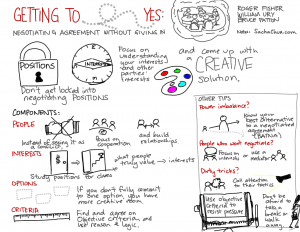Consciously Resolve Conflict
While we know conflict is part of life, it still can catch us by surprise and throw us off our ‘conscious communicator’ game. To stay present and bring our best selves forward when conflict arises we need to be knowledgeable and practice being present with discomfort.
In terms of being knowledgeable, there is both understanding the nature of conflict resolution and being prepared to face a specific conflict.
Let’s review conflict basics. There are four elements necessary for conflict: opposing forces, interdependence, affect or emotions, and perceived differences. It is helpful to remember that there needs to be an interdependence in order for there to be a conflict in the first place; there is a connection at some level between the conflicting parties that you can use to help solve the conflict. The word ‘perceived’ is also a key part of the definition because perceptions can change, and as perceptions change options for resolving conflict can arise.
Now, let’s consider the five styles used in approaching conflict set out by Kilmann & Thomas:
- Avoidance – passively ignore conflict – this is usually counterproductive unless it is used for cooling off before addressing the conflict or for minor issues.
- Competition – pursuing only own goals – this is productive for only one person, it is a win-lose situation.
- Accommodation – defer to others – this is productive for the other person, it is a lose-win situation and tends to build resentment.
- Compromise – give and take – this is a productive style and can be thought of as the middle ground where each party wins some and loses some. Compromise is the most common (positive) style of solving conflict.
- Collaboration – finding a new alternative together – this is a win-win where both parties walk away feeling they gained something, but it takes time and is difficult to achieve. Collaboration leads to the best outcomes for both parties in a conflict.
Fisher and Ury developed Principled Negotiations, which is a collaboration style of resolving conflict with four action items that are illustrated in the graphic below; separate the people from the problem, focus on interests, not positions, invent options for mutual gain, and use objective criteria for resolution. An example of a position is pro tax increase; the interests for that position might be fairness for all citizens or support for public servants. By focusing on the interests or motivations behind the positions of each party, it opens up possibility of options for mutual gain.
Source: sachachua.com
Of course, even after we have refreshed our memory on the nature of conflict and resolution, we still need to prepare for a specific conflict. Sometimes we know in advance that we will be facing conflict. Then we can prepare by figuring out exactly what we want, what the other party wants (to the best of our knowledge), what we are willing to give away, and lastly what options we have if negotiations fail. Other times we walk into a conflict in the moment and need to gather our thoughts and composure on the spot. In these cases, our ability to be with discomfort is as important as our critical thinking. This takes practice.
Any time we are upset at things that doesn’t go our way, we have the opportunity to try and be our best selves in that moment. One technique for doing so is Tara Brach’s RAIN.
R stands for recognize – pause, take a breath, focus inward and become aware of what is happening inside of you at this very moment. I find it helpful to name it – upset, anger, tension, or fear.
A stands for allow – instead of trying to push away the discomfort, just allow it to be.
I stands for investigate – kindly look at your inner experience from a higher perspective to discover what is being triggered in you and what patterns you see.
N stands for non-identification – realize that you are not your current feelings and that, like everything else in this universe, the current situation is not permanent.
This RAIN technique takes just a moment, and it can create a major shift in perspective that allows you to be more open-minded and openhearted, while still advocating for yourself during a conflict.
To further develop your conflict resolution techniques, you can refer to negotiation expert William Ury’s new book, Getting to Yes with Yourself and the six steps he recommends.
As we all face conflicts, some big and some small, bringing our best self forward by being present with discomfort and brushing up our resolution techniques can help us consciously connect with fellow humans.

